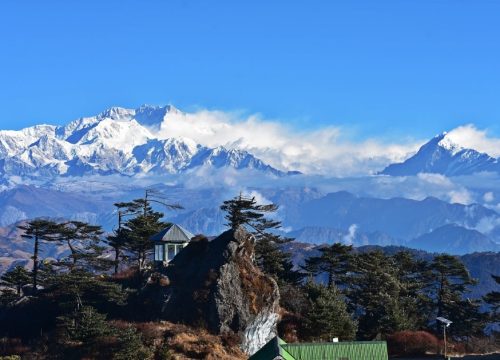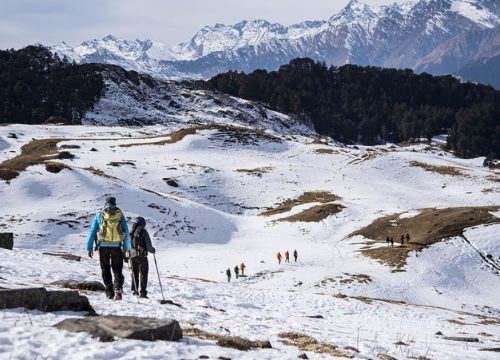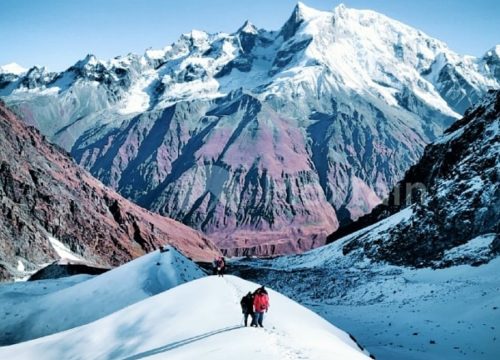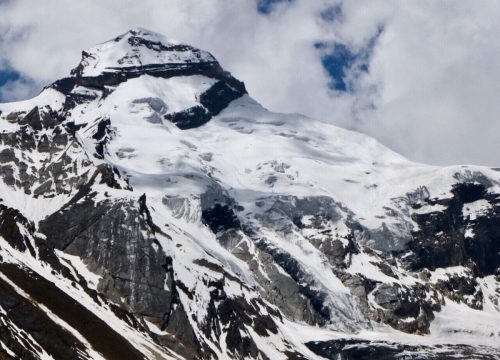Sandakphu Trek
Sandakphu Trek
The Sandakphu Trek is one of the most rewarding Himalayan journeys in India, famous for offering a rare view of the world’s four highest peaks—Everest, Kanchenjunga, Lhotse, and Makalu—all in a single sweeping panorama. Located in the Darjeeling district of West Bengal, this trek follows the Singalila Ridge, which naturally forms a boundary between India and Nepal. At its highest point, Sandakphu (3,636 m / 11,941 ft), trekkers are rewarded with a grand 180° view of snow-clad giants, including the majestic Sleeping Buddha formation of the Kanchenjunga range.
What makes the Sandakphu trek unique is the blend of natural beauty and cultural experiences. The trail passes through charming villages like Tumling, Gairibas, and Kalipokhri, where trekkers get to interact with locals and stay in tea houses or homestays instead of tents, making it beginner-friendly. The route lies inside the Singalila National Park, home to the elusive red panda, Himalayan black bear, and a wide range of birds. During spring, the forests are ablaze with blooming rhododendrons, magnolias, and orchids, while autumn offers crystal-clear skies and uninterrupted views of the mountains.
How to Reach Sandakphu Trek
Reaching the Sandakphu Trek requires traveling first to the base village of Manebhanjan, located in the Darjeeling district of West Bengal, on the border with Nepal. Manebhanjan sits at around 2,150 meters and acts as the gateway to the Singalila National Park, from where the trek officially begins. Getting here involves multiple transport options by air, rail, and road, depending on where you’re starting your journey.
🛫 By Air
The nearest airport is Bagdogra Airport (IXB), which is about 115 km from Manebhanjan. Bagdogra is well connected with major Indian cities like Delhi, Kolkata, Guwahati, and Bangalore. From the airport, you can:
Take a taxi/private cab: Direct taxis to Manebhanjan take around 5–6 hours.
Travel via Darjeeling or Siliguri: Many trekkers stop at Darjeeling (80 km from Bagdogra) for a night and then continue to Manebhanjan the next morning.
🚂 By Train
The nearest major railway station is New Jalpaiguri (NJP), about 118 km away. NJP is a key junction in North Bengal, connecting to cities such as Kolkata, Delhi, Mumbai, and Guwahati. From NJP, you can:
Hire a cab to reach Manebhanjan directly (5–6 hrs drive).
Travel to Darjeeling by road or the iconic Darjeeling Himalayan Railway (Toy Train), then take a shared jeep or taxi to Manebhanjan.
🚌 By Road
From Siliguri (110 km) or Darjeeling (26 km), taxis and shared jeeps are easily available.
Manebhanjan lies on the Darjeeling–Mirik–Sukhiapokhri route, making it well connected by road.
Roads are steep and winding, so expect slower travel times than usual plains journeys.
🚙 Transport Options from NJP/Bagdogra
Shared Jeeps: Available from Siliguri and Darjeeling; cheaper but more time-consuming and crowded.
Private Taxis: Comfortable option, especially if traveling with a group; can be booked at the airport or railway station.
Pre-Arranged Transport: Many trekking companies arrange pick-up from NJP/Bagdogra for convenience.
🏔️ Last Leg: Manebhanjan to Sandakphu
From Manebhanjan, the trek to Sandakphu begins, but there’s also the option to travel partway by Land Rovers. These vintage vehicles, dating back to the 1960s, are still in use and managed by the Land Rover Owners’ Association. They can take you up to Sandakphu or Phalut if you prefer a jeep safari instead of trekking. However, most trekkers choose to hike, as the route through Singalila National Park is a key part of the experience.
🛕 Permit Requirements
Since the trail runs inside Singalila National Park, you must obtain an entry permit. This is available at the forest check post in Manebhanjan. Additionally, because the trek runs along the India–Nepal border, you should carry a valid government-issued photo ID (like Aadhaar, Passport, or Voter ID), which is checked at various points on the trail.
📍 Travel Summary
Fly or take a train to Bagdogra Airport (115 km) or NJP Railway Station (118 km).
Drive to Manebhanjan via Siliguri or Darjeeling (5–6 hours).
Obtain necessary permits at Manebhanjan Forest Office.
Begin the trek to Sandakphu (3,636 m) via Tumling, Kalipokhri, and other villages.
In short, the journey to the Sandakphu trek is as scenic as the trek itself — winding roads through tea gardens, misty forests, and mountain views build anticipation for the adventure ahead.
Near Places To Sandakphu Trek
1. Darjeeling (Approx. 26 km from Manebhanjan)
Often called the “Queen of the Hills”, Darjeeling is a must-visit before or after your trek. Famous for its rolling tea estates, colonial charm, and vibrant culture, it offers experiences like:
Tiger Hill Sunrise: Another vantage point for Kanchenjunga views.
Darjeeling Himalayan Railway (Toy Train): A UNESCO World Heritage ride.
Tea Gardens: Tour estates like Happy Valley or Makaibari.
Monasteries & Culture: Ghoom Monastery, Tibetan Refugee Centre.
2. Mirik (Approx. 40 km from Manebhanjan)
A peaceful hill town known for Sumendu Lake, orange orchards, and cardamom plantations. Mirik is less crowded than Darjeeling and perfect for relaxation.
3. Kalimpong (Approx. 80 km from Manebhanjan)
Set on a ridge overlooking the Teesta River valley, Kalimpong offers:
Colonial-era churches and old schools.
Flower nurseries (especially orchids and gladioli).
Durpin Monastery and scenic viewpoints.
4. Sandakphu–Phalut Extension
If you have time, extend your trek from Sandakphu to Phalut (3,600 m), another high ridge point. Phalut offers even closer views of Kanchenjunga, often considered more dramatic than Sandakphu. It also provides 360° panoramas of Sikkim, Bhutan, and Nepal ranges.
5. Singalila National Park (Entire Trek Region)
Though trekkers pass through it, the park itself deserves mention. It’s a biodiversity hotspot famous for:
Red pandas, Himalayan black bear, and barking deer.
Birdwatching: Satyr tragopan, blood pheasant, and Himalayan monal.
A paradise for wildlife photographers and naturalists.
6. Siliguri (Transit Hub, 110 km away)
A bustling city at the Himalayan foothills, often a stopover for trekkers. Known for its:
Mahananda Wildlife Sanctuary.
Shopping in Hong Kong Market.
Local food experiences with Nepali, Bengali, and Tibetan influences.
7. Nepal Side Villages (Tumling, Chitrey, Meghma, Kalipokhri)
Since much of the trail runs along or within Nepal, these villages offer unique experiences:
Stay in traditional Nepali homestays.
Taste local food like dhido, thukpa, and momos.
Explore monasteries and interact with warm local communities.
8. Sikkim Excursions (Post-Trek Options)
If you have more days, combine Sandakphu with Sikkim exploration:
Pelling: For Kanchenjunga views and Pemayangtse Monastery.
Yuksom: Gateway to the Goechala Trek.
Gangtok: For a mix of culture, monasteries, and Himalayan landscapes.
Other Tours
- Adi Kailash
- Aulli
- Bali Pass Trek
- Bararsar Lake
- Borasu Pass Trek
- Brahmatal Trek
- Chopta
- Dayara Bugyal Trek
- Goechala Trek
- Har Ki Dun Trek
- Haridwar
- Jungle Safari
- kausani
- Kedarkantha Trek
- Kuri Pass
- Maldaru Tal Trek
- Manali
- Munsiyari
- Nagtibba Trek
- Nainital
- Neem Karoli Baba Ashram Kainchi Dham
- Panch Kedar
- Ruinsara Lake
- Rupin Pass Trek
- Sandakphu Trek
- Valley Of Flowers Trek
Quick Links
Itinerary
Travel: Arrive at New Jalpaiguri Railway Station (NJP) or Bagdogra Airport. Drive for 5–6 hours (118 km) via Siliguri, Mirik, and Sukhiapokhri to reach Manebhanjan, the base of the trek.
Highlights: Scenic tea gardens of Darjeeling hills, winding mountain roads, glimpses of Nepalese villages.
Stay: Guesthouse/homestay in Manebhanjan.
Tip: This day is crucial for rest and acclimatization after the long journey from the plains.
Trek Distance: ~11 km | Duration: 6–7 hrs.
Begin with a steep uphill climb through pine and rhododendron forests. Cross Chitrey monastery and prayer flags fluttering on ridges.
The trail moves along the India–Nepal border, giving trekkers the chance to walk in and out of Nepal.
Stay: Tea houses in Tumling (Nepal side).
Highlights: Panoramic valley views, interaction with locals, and your first clear view of the Kanchenjunga range if the weather is clear.
Trek Distance: ~13 km | Duration: 6–7 hrs.
Walk through the dense forests of Singalila National Park, home to the red panda and exotic birds.
Descend to Gairibas, then climb gradually to Kalipokhri Lake, named for its dark waters. Buddhist prayer flags flutter around the lake, giving it a spiritual aura.
Stay: Homestays/tea houses in Kalipokhri.
Highlights: Shady bamboo forests, wildflowers in spring, and the peaceful Kalipokhri Lake at sunset.
Trek Distance: ~6 km | Duration: 3–4 hrs.
A steady uphill walk, passing through rugged landscapes and small ridges.
By afternoon, reach the summit of Sandakphu, the highest point in West Bengal.
View from Sandakphu: A jaw-dropping 180° panorama of the Sleeping Buddha (Kanchenjunga range) along with Mount Everest, Lhotse, and Makalu in the distance.
Stay: Tea houses/lodges at Sandakphu.
Highlights: Sunset over the Himalayan peaks, stargazing in the crystal-clear night sky.
Trek Distance: ~21 km | Duration: 7–8 hrs (challenging but rewarding).
This day is optional but highly recommended for trekkers with good stamina.
The trail to Phalut is one of the most scenic sections of the trek, with alpine meadows, oak forests, and closer views of Kanchenjunga.
Stay: Basic hut/trekker’s lodge at Phalut.
Highlights: Uninterrupted mountain views, pristine wilderness, and fewer crowds.
Trek Distance: ~15 km | Duration: 6–7 hrs.
A long descent through forests of rhododendron, magnolia, and oak. In spring, the trail looks like a flower tunnel.
Arrive at Gurdum, a quiet riverside village surrounded by terraced farms.
Stay: Homestay in Gurdum.
Highlights: Peaceful environment, authentic Nepalese and Sherpa cuisine, interaction with villagers.
Trek Distance: ~6 km | Duration: 2–3 hrs trek.
Descend to Srikhola, a charming hamlet by a mountain river. This marks the end of your trek.
From Srikhola, drive back to NJP/Bagdogra (6–7 hrs).
Highlights: River-crossings, final glimpses of the hills, and a celebratory mood after completing the trek.
Duration: 6–7 days (including travel)
Trek Distance: ~52–65 km (depending on Phalut extension)
Difficulty: Easy to Moderate (suitable for beginners with good fitness)
Best Seasons:
Spring (Mar–Apr): Blooming rhododendrons & orchids.
Autumn (Oct–Nov): Clear skies, crisp mountain views.
Winter (Dec–Jan): Snow-covered trails, but very cold.
Book a Tour
Frequently Asked Questions for Sandakphu Trek
The trek is rated easy to moderate. The trail includes gradual ascents, a few steep climbs (like Manebhanjan to Chitrey), and long walking days. It is suitable even for beginners with average fitness, provided they prepare with regular walking or light cardio beforehand.
Spring (March–April): The trail blooms with rhododendrons, magnolias, and orchids, making it the most colorful season.
Autumn (October–November): Offers the clearest mountain views of Kanchenjunga and Everest.
Winter (December–January): Snow on trails, great for adventure lovers, but very cold.
Not mandatory. It’s beginner-friendly but having some hiking experience helps. Fitness preparation is recommended.
Yes, entry into Singalila National Park requires a permit, which can be obtained at Manebhanjan Forest Office. Indian trekkers need a government photo ID, while foreign nationals need their passport and visa.
Sandakphu (3,636 m) is the highest point in West Bengal and offers a 360° Himalayan panorama. You can see the Sleeping Buddha formation (Kanchenjunga range) and also Mount Everest, Lhotse, and Makalu in the distance.




